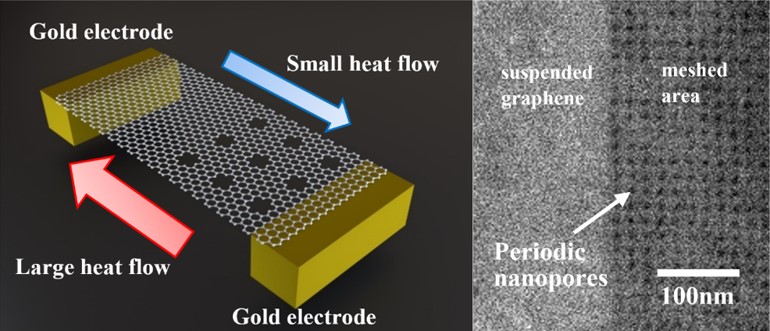| Jan 07, 2022 |
Heat rectification via suspended asymmetric graphene nanomesh
(Nanowerk News) Currently, researchers at the Japan Advanced Institute of Science and Technology (JAIST) have demonstrated a promising asymmetric graphene nanomesh device that shows a high thermal rectification ratio at low temperatures. The experiment provides a practical guideline for developing a high-efficiency thermal rectifier based on graphene nanomesh structure.
|
|
The findings are published in Nano Futures ("Thermal rectification on asymmetric suspended graphene nanomesh devices").
|
 |
| Figure 1: Schematic illustration of the asymmetric graphene nanomesh device, and the periodic nanopores (nanomesh) fabricated on suspended graphene using state-of-the-art focused helium ion beam technology. (Image: JAIST)
|
|
The thermal rectifier was firstly demonstrated by Starr C. in 1936, in which the heat flux from one direction is larger than the opposite direction as similar as an electrical diode. The conventional mechanism in bulk materials is based on the different temperature dependence of the thermal conductivities in two different composition materials.
|
|
However, most of the demonstrated results based on this mechanism show a low rectification ratio of around 10%–20%. Moreover, in nanoscale devices, it is almost impossible to know the thermal conductivities for each part of a thermal rectifier. Under this condition, a new strategy to develop a high-performance thermal rectifier is highly demanded.
|
|
A phonon research team led by Dr. Fayong Liu and Prof. Hiroshi Mizuta from JAIST, in collaboration with researchers at the National Institute of Advanced Industrial Science and Technology (AIST), has demonstrated that the thermal rectification phenomenon can be observed with a high ratio up to 60% on suspended asymmetric graphene nanomesh devices at low temperatures (150K and 250K).
|
|
They introduce graphene nanomesh as an artificial phononic crystal structure on half the area of the heat flux channel (Figure 1). The nanopore diameter is 6 nm approximately, and the pitch is 20 nm. With the help of the ‘differential thermal leakage’ method, heat flux measurement is not disturbed by the leakage of electron current through the suspended channel. The research is focused on phonon transport properties of this kind of new device structure.
|
|
“This research outcome is a significant advancement towards the practical application of graphene to thermal management. It is also a notable milestone for our final aim to apply graphene to build a greener world”, says Prof. Hiroshi Mizuta, the Head of Mizuta Lab. The Mizuta lab is focusing on fundamental physics and potential applications of graphene-based devices. This research provides a systematic way to enhance the performance of the thermal rectifier and also raises the possibility to extend it to room temperature applications.
|

